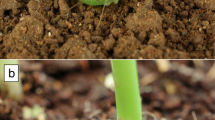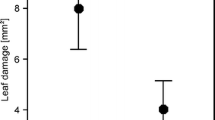Abstract
We observed the movement of predatory larvae of the syrphid flyEupeodes corollae (F.) (formerlyMetasyrphus corollae) among small pea plants with and without aphids. Starved larvae spent longer time than well-fed larvae on similar plants and both groups of larvae stayed longer on plants with aphids than on plants without aphids. On plants with aphids, larvae which failed to capture prey left the plant sooner than those which captured aphids. The capture of at least one aphid on a plant increased the persistence of syrphid larvae. The average rate of energy gain was higher for well-fed larvae than for starved larvae because starved larvac stayed on plants even when their rate of return was lower. When larvae that had captured aphids left plants, their rate of energy gain, tended to be lower than at any time following capture of the 2nd, aphid. The 1st aphid was captured in less time than similar larvae spent on plants without aphids. Time between captures of aphids by well-fed larvae was less than the time such larvae spent on plants without aphids. Among starved larvae, the intercatch intervals were similar to the time on plants without aphids. We discuss the significance of these results relative to current predator foraging theory and the efficiency ofE. corollae as a biological control agent.
Résumé
Nous avons observé les déplacements des larves prédatrices du syrpheEupeodes corollae (F.) sur des plantes de pois infestés ou non de pucerons. Les larves affamées ont passé plus de temps, sur les plants que les larves bien nourries. Les 2 groupes de larves sont restés plus longtemps sur les plants avec pucerons que sur les plants qui en étainet dépourvus. Sur les plants infestés de pucerons, les larves incapables d'en capturer quittèrent le plant plus tôt que les larves qui réussirent. La capture d'au moins un puceron sur un plant, augmentait la persistance des larves prédatrices. Le taux moyen de gain énergétique était plus élevé pour les larves bien nourries parce que pour les affamées celles-ci restaient sur les plants même si leur succès de capture était peu élevé. Lorsque les larves qui avaient capturé des pucerons quittaient les plants, leur taux de gain énergétique avait tendance à être plus bas qu'après la capture d'un deuxième puceron. Le temps nécessaire à la capture du 1er puceron était plus court que celui passé par ces larves sur un plant dépourvu de pucerons. Le temps écoulé entre les captures de pucerons par les larves bien nourries était plus court que celui passé par ces mêmes larves sur des plants dépourvus de pucerons. Chez les larves affamées, le temps écoulé entre les captures était semblable à celui passé sur les plants dépourvus de pucerons. Nous avons examiné la portée de ces résultats en rapport avec la théorie courante de recherche de nourriture chez les prédateurs, et avec l'efficacité deE. corollae en tant qu'agent de lutte biologique.
Similar content being viewed by others
References
Barlow, C. A. — 1979. Energy utilization by larvae of a flowerfly,Syrphus corollae [Diptera: Syrphidae]. —Can. Entomol., 111, 897–904.
Barlow, C. A. &Whittingham, J. — 1986. Feeding economy of larvae of a flower fly,Metasyrphus corollae [Diptera: Syrphidae]: partial consumption of prey. —Entomophaga, 31, 49–57.
Bond, A. B. — 1980. Optimal foraging in a uniform habitat: the search mechanism of the green lacewing. —Anim. Behav., 28, 10–19.
Bond, A. B. — 1981. Giving-up as a Poisson process: the departure decision of the green lacewing. —Anim. Behav., 29, 629–630.
Chandler, A. E. F. — 1969. Locomotory behaviour of first instar larvae of aphidophagousSyrphidae (Diptera) after contact with aphids. —Anim. Behav., 17, 673–678.
Charnov, E. L. — 1976. Optimal foraging, the marginal value theorem. —Theor. Pop. Biol., 9, 129–136.
Cornelius, M. &Barlow, C. A. — 1980. Effect of aphid consumption on development and reproductive efficiency of a flowerfly,Syrphus corollae [Diptera: Syrphidae]. —Can. Entomol., 112, 898–992.
Hassell, M. P. — 1978. The Dynamics of Arthropod Predator-Prey Systems. Monographs in Population Biology No. 13. —Princeton University Press Princeton, New Jersey, 237 pp.
Kohler, S. L. — 1984. Search mechanism of a stream grazer in patchy environments: the role of food abundance. —Oecologia, 62, 209–218.
Krebs, J. R., Ryan, J. &Charnov, E. L. — 1974. Hunting by expectation or optimal foraging? A study of patch use by chickadees. —Anim. Behav., 22, 953–964.
McNair, J. N. — 1982. Optimal giving-up times and the marginal value theorem. —Amer. Natur., 119, 511–529.
Munger, J. C. — 1984. Optimal foraging? Patch use by horned lizards [Iguanidae: Phyrnosoma]. —Am. Nat., 123, 654–680.
Roitberg, B. D. &Prokopy, R. J. — 1984. Host visitation sequence as a determinant of search persistence in fruit parasitic tephritid flies. —Oecologia, 62, 7–12.
Rotheray, G. E. &Martinat, P. — 1984. Searching behaviour in relation to starvation ofSyrphus ribesii. —Entomol. Exp. Appl., 36, 17–21.
Scott, S. M. — 1983. The effect of prey availability on the reproductive output and foraging behaviour of a flowerfly,Metasyrphus corollae [Diptera: Syrphidae]. —Ph. D. thesis, Carleton University, Ottawa, Canada.
Scott, S. M. &Barlow, C. A. — 1984. Effect of prey availability during development on the reproductive output ofMetasyrphus corollae [Diptera: Syrphidae]. —Environ. Entomol., 13, 669–674.
Scott, S. M. & Barlow, C. A. — 1990. Changes in foraging tactics by larvalMetasyrphus corollae [Diptera: Syrphidae] in response to hunger and light. In prep.
Sokal, R. R. &Rohlf, F. J. — 1969. Biometry. —W. H. Freeman & Co, San Francisco, 776 pp.
Thoni, H. — 1969. A table for estimating the mean of a lognormal distribution. —J. Am. Stat. Assoc., 64, 632–636.
Waage, J. K. — 1979. Foraging for patchily-distributed hosts by the parasitoidNemeritis canescens. —J. Anim. Ecol., 48, 353–371.
Author information
Authors and Affiliations
Rights and permissions
About this article
Cite this article
Scott, S.M., Barlow, C.A. Effect of hunger on the allocation of time among pea plants by the larvae of an aphidophagous hover fly,Eupeodes corollae [Dipt: Syrphidae] . Entomophaga 35, 163–172 (1990). https://doi.org/10.1007/BF02374790
Received:
Accepted:
Issue Date:
DOI: https://doi.org/10.1007/BF02374790




